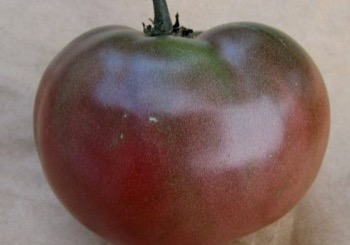Grafting Heirloom Tomatoes for Increased Yields and Quality
Tomatoes are grafted by joining the top of one plant (the scion) to the root system of another (the rootstock). The subsequent plant is more vigorous and productive. Several studies have been done over the last 10 years that show the benefits of using grafting for soil disease control in tomato production, but there is not much research that examines the influence of rootstocks when there is no disease in a tomato high tunnel production system.

In general, grafting has been shown to enhance yield and improve crop tolerance. We looked at what would be the benefit, if any, of grafting an heirloom tomato variety, Cherokee Purple, (fig. 1) onto a more vigorous rootstock (Maxifort) in a high tunnel production system. The data from this first year of study are still being worked on so this will act as a general summary as to what was done and what was found.
Methods
Grafting treatments consisted of three combinations: a scion/rootstock graft, a non-grafted control, and a self-grafted control (the scion and root stock were from different plants but the same variety (Cherokee Purple) to test for any ‘grafting effects’. Six weeks after grafting, all grafted and non-grafted plants were transplanted into the HT on March 15th. Black plastic mulch and drip irrigation were used. There were six rows that were 40ft long. Each row (plot) was divided into 20 ft sections, 10 tomatoes spaced 2 ft apart per plot. There were 4 replications.
Leaf tissue samples were taken at first flower bud and every two weeks throughout the study. Fruit harvests were conducted two-three times per week and sorted into marketable and non-marketable components. Non-marketable fruit categories consisted of: yellow shoulders, uneven ripening, cat-facing, blossom end rot, fruit cracking and ‘other’. Fruit number and weight were recorded.
Results
Overall grafted plants (mean of 18.3 lbs/plant) had significantly greater yields of marketable fruit compared with non-grafted (14.5 lbs/plant) and self-grafted plants (13.8 lbs/plant). Grafted plants had on average 18% greater leaf tissue nutrient concentrations for N and P. The all-important nutrient K was 23% greater in grafted plants vs. self-grafted and non-grafted plants. Grafted plants had 25% greater overall yields, with ~30% greater marketable fruit yield compared with the non-grafted and self-grafted plants. Early, middle and later harvests were all about equal among the grafted and non-grafted plants, although there was a trend for grafted plants to have lower early yields compared with non-grafted plants. It does look possible, at least from this 1st year of study to increase yields and quality in heirloom tomatoes just by grafting the heirloom plant onto more vigorous root stock. But more data from different sites and in multiple years will be needed before we can say it is consistently cost-effective to graft heirloom plants in the absence of any disease problems.
